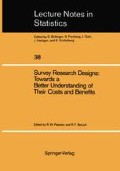Abstract
Lord’s Paradox is analyzed in terms of a simple mathematical model for causal inference. The resolution of Lord’s Paradox from this perspective has two aspects. First, the descriptive, non-causal conclusions of the two hypothetical statisticians are both correct. They appear contradictory only because they describe quite different aspects of the data. Second, the causal inferences of the statisticians are neither correct nor incorrect since they are based on different assumptions that our mathematical model makes explicit, but neither assumption can be tested using the data set that is described in the example. We identify these differing assumptions and show how each may be used to justify the differing causal conclusions of the two statisticians. In addition to analyzing the classic “diet” example which Lord used to introduce his paradox, we also examine three other examples that appear in the three papers where Lord discusses the paradox and related matters.
The preparation of this paper was supported in part by the Program Statistics Research Project, Educational Testing Service, Princeton, New Jersey 08541. This chapter was prepared for the Festschrift in honor of Frederick M. Lord, May 22–23, 1982, and was the basis of a presentation at the Social Science Research Council’s Seminar, Designing Research With Scarce Resources, November 11–12, 1982, Washington, D. C.
Access this chapter
Tax calculation will be finalised at checkout
Purchases are for personal use only
Preview
Unable to display preview. Download preview PDF.
References
Anderson, S. B. et al. 1973. Encyclopedia of Educational Evaluation. San Francisco, CA: Jossey-Bass.
Evans, S. H. and Anastasio, E. J. 1968. Misuse of analysis of covariance when treatment effect and covariate are confounded. Psychological Bulletin, 69:225–234.
Games, P. A. 1976. Limitations of analysis of covariance on intact group quasi-experimental designs. Journal of Experimental Education, 44:51–54.
Holland, P. W. and Rubin, D. B. 1980. Causal inference in case-control studies. Jerome Cornfield Memorial Lecture, American Statistical Association Meetings, Houston, August.
Lindley, D. V. and Novick, M. R. 1981. The role of exchangeability in inference. Annals of Statistics 9:45–58.
Lord, F. M. 1967. A paradox in the interpretation of group comparisons. Psychological Bulletin 68:304–305.
Lord, F. M. 1968. Statistical adjustments when comparing preexisting groups. Psychological Bulletin 72:336–337.
Lord, F. M. 1973. Lord’s paradox. In Encyclopedia of Educational Evaluation. Anderson, S.B. et al. San Francisco: Jossey-Bass.
Rosenbaum, P. R. and Rubin, D. B. 1982. The central role of the propensity score in observational studies. Biometrika.
Rubin, D. B. 1974. Estimating causal effect of treatments in randomized and non-randomized studies. Journal of Educational Psychology 66:688–701.
Rubin, D. B. 1977. Assignment of treatment group on the basis of a covariate. Journal of Educational Statistics 2:1–26.
Rubin, D. B. 1978. Bayesian inference for causal effects: The role of randomization. The Annals of Statistics 7:34–58.
Rubin, D. B. 1980. Discussion of “Randomization analysis of experimental data in the Fisher randomization test,” by Basu. The Journal of the American Statistical Association 75:591–593.
Editor information
Editors and Affiliations
Rights and permissions
Copyright information
© 1986 Springer-Verlag Berlin Heidelberg
About this chapter
Cite this chapter
Holland, P.W., Rubin, D.B. (1986). Research Designs and Causal Inferences: On Lord’s Paradox. In: Pearson, R.W., Boruch, R.F. (eds) Survey Research Designs: Towards a Better Understanding of Their Costs and Benefits. Lecture Notes in Statistics, vol 38. Springer, New York, NY. https://doi.org/10.1007/978-1-4684-6336-1_2
Download citation
DOI: https://doi.org/10.1007/978-1-4684-6336-1_2
Publisher Name: Springer, New York, NY
Print ISBN: 978-0-387-96428-7
Online ISBN: 978-1-4684-6336-1
eBook Packages: Springer Book Archive

